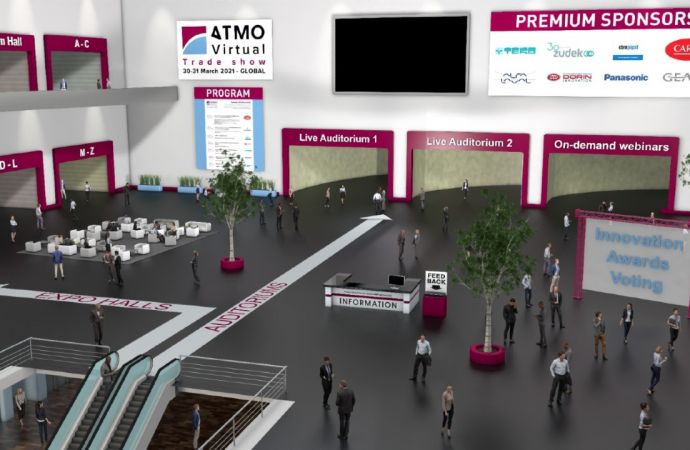Session 3 of day two of the 10th Gustav Lorentzen conference in Delft, Netherlands centred around compressors, a key part of an efficient refrigeration system using ammonia as a natural refrigerant. The papers presented highlighted some of the most efficient designs to improve reliability and increase efficiency and life time of ammonia compressors.

New capacity control for ammonia chiller screw compressors with high part load efficiency, by Dmytro Zaytsev
This presentation discussed load conditions and the internal volume index (Vi) control as decisive factors of ammonia chiller screw compressors’ economic efficiency. More specifically, Zaytsev highlighted how to guarantee chiller compressor ability to run efficiently in part load, the most common mode of operation, especially in countries with seasonal temperature variations.
The author compared the results of four different designs options: single slide capacity control, parallel slide, tandem slide control, and a newly developed single Vi-slide system with variable speed drive.
It appears that, according to the European seasonal energy efficiency ratio (ESEER, Eurovent Institute, Europe), the last system, using a new ammonia chiller compressor developed by GEA Refrigeration Technologies, has the best coefficient of performance (COP) in part load:
New high efficient piston compressors for NH3, George Bon
Author George Bon described challenges for designing more efficient and reliable ammonia reciprocating compressors lowering the total cost of ownership (TCO).
His presentation, based on simple tests with air and water, extreme laboratory tests and real life measurements, focused on the 3 basic elements of a compressor’s housing design: internal temperature management, gas velocities and distribution, and internal liquid separation.
The author explained that manufacturers need to reduce localised high temperature and maintain low overall temperature in the housing. Decrease internal heat transfer between discharge heads and suction chamber, and between the crank case and the suction chamber leads to a higher life expectancy of ammonia piston compressors.
Mr Bon concluded that design robustness also depends on preventing liquid entering the compressor. A good liquid separation in the suction chamber is key to optimize ammonia pistons compressors efficiency.
Dedicated compressor technology for a next generation domestic heat pump, Edo Bart Wissink
Wissink presented the results of current research activities lead by TNO, an independent research organisation in Netherlands, on a just patented techonology for low capacity compressors so called torsion drive technology.
TNO is proposing an alternative to traditional small capacity scroll, reciprocating piston or rotary compressors whose efficiency is usually limited due to high mechanical frictions between piston and cylinder and important gas or oil flow losses.
According to the author, this new semi-free piston system combines innovative design properties such as reduced internal mechanical frictions, small size integrated electromotor, hermetic and fully symmetric design. According to the authors, the compressor will have an increased efficiency at a better total cost of ownership (CTO).
Next planned activities for TNO are detailed engineering and optimisation to build and test their first prototype.
The 10th Gustav Lorentzen conference proceedings consist of 141 peer-reviewed papers from 31 countries. ammonia21.com will report next week about other presentations focused on NH3 heat pumps and chillers.
This presentation discussed load conditions and the internal volume index (Vi) control as decisive factors of ammonia chiller screw compressors’ economic efficiency. More specifically, Zaytsev highlighted how to guarantee chiller compressor ability to run efficiently in part load, the most common mode of operation, especially in countries with seasonal temperature variations.
The author compared the results of four different designs options: single slide capacity control, parallel slide, tandem slide control, and a newly developed single Vi-slide system with variable speed drive.
It appears that, according to the European seasonal energy efficiency ratio (ESEER, Eurovent Institute, Europe), the last system, using a new ammonia chiller compressor developed by GEA Refrigeration Technologies, has the best coefficient of performance (COP) in part load:
- Air cooled chiller COP = 7 for 50% refrigeration load
- Water cooled chiller COP = 9 for 50% refrigeration load
New high efficient piston compressors for NH3, George Bon
Author George Bon described challenges for designing more efficient and reliable ammonia reciprocating compressors lowering the total cost of ownership (TCO).
His presentation, based on simple tests with air and water, extreme laboratory tests and real life measurements, focused on the 3 basic elements of a compressor’s housing design: internal temperature management, gas velocities and distribution, and internal liquid separation.
The author explained that manufacturers need to reduce localised high temperature and maintain low overall temperature in the housing. Decrease internal heat transfer between discharge heads and suction chamber, and between the crank case and the suction chamber leads to a higher life expectancy of ammonia piston compressors.
Mr Bon concluded that design robustness also depends on preventing liquid entering the compressor. A good liquid separation in the suction chamber is key to optimize ammonia pistons compressors efficiency.
Dedicated compressor technology for a next generation domestic heat pump, Edo Bart Wissink
Wissink presented the results of current research activities lead by TNO, an independent research organisation in Netherlands, on a just patented techonology for low capacity compressors so called torsion drive technology.
TNO is proposing an alternative to traditional small capacity scroll, reciprocating piston or rotary compressors whose efficiency is usually limited due to high mechanical frictions between piston and cylinder and important gas or oil flow losses.
According to the author, this new semi-free piston system combines innovative design properties such as reduced internal mechanical frictions, small size integrated electromotor, hermetic and fully symmetric design. According to the authors, the compressor will have an increased efficiency at a better total cost of ownership (CTO).
Next planned activities for TNO are detailed engineering and optimisation to build and test their first prototype.
The 10th Gustav Lorentzen conference proceedings consist of 141 peer-reviewed papers from 31 countries. ammonia21.com will report next week about other presentations focused on NH3 heat pumps and chillers.
MORE INFORMATION
Related stories



